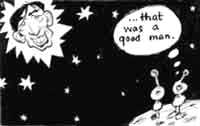The numbers game
 with the death of Carl Sagan, a philosopher-astronomer, in December 1996, the world has lost a great person who popularised science. The impact that Sagan had on the us and on the rest of the world is evident from the fact that his book Cosmos is an all-time bestseller. In fact, the television series based on the book was seen by over half a billion people worldwide.
with the death of Carl Sagan, a philosopher-astronomer, in December 1996, the world has lost a great person who popularised science. The impact that Sagan had on the us and on the rest of the world is evident from the fact that his book Cosmos is an all-time bestseller. In fact, the television series based on the book was seen by over half a billion people worldwide.
The timing of the release of Billions and Billions... could scarcely have been better, coming as it does about the time the p ath-finder is exploring Mars for signs of life and coinciding with the release of the film Contact , based on Sagan's novel of the same name. Sagan speaks from beyond the grave as it were, as he expands on his thoughts on life and death at the brink of the millennium, as the sub-title of the book suggests.
The book consists of three parts. The first is mainly on quantification, the second is on the environment, while the last part is largely a patchwork from articles that Sagan had previously published. Thus, the book is a bit of a cut-and-paste job and lacks continuity.
In the very first chapter, Sagan explains that he had never used the term "billions and billions", a term that all Americans identified him with, much in the same way that Sherlock Holmes never said "Elementary, my dear Watson". The closest that he ever got to it was when he used the word "billion" in Cosmos - and when Johny Carson, the television anchor, imi-tated Sagan saying "billions and billions" on his 'Tonight show ' . For those with a fear of numbers, Sagan offers sound advice: "Being afraid of quantification is tantamount to disenfranchising yourself, giving up on one of the most potent prospects for understanding and changing the world."
We learn that the four questions that interes-ted him most were: whether there was ever life on Mars; whether Titan, the largest moon of Saturn and the only satellite in the solar system known to have clouds and a dense atmosphere, is a laboratory for the origin of life; is there life elsewhere; and the origin and fate of the universe.
The second section of the book, which deals with the environment, is the most interesting. Issues like the holes in the ozone layer and global warming are discussed in fair amount of detail and the write-up is a good introduction to those who are unclear about the importance of these issues. In particular, the chapter "The environment: where does prudence lie?" ought to be read by all - especially those who do not subscribe to the importance of the environment and its conservation.
Here Sagan explains why, in the battle between the worrywarts and the non-believers, we have reason to believe the former and why we should step in and do something before it is too late. The us , with five per cent of the world's population, uses 25 per cent of the world's energy. Automobiles are responsible for about a third of the carbon dioxide production in the us . Yet, usa is the only major industrialised nation that is not taking significant measures to counter the greenhouse effect. Smaller fuel-efficient cars, use of solar energy and the planting of trees by individuals and industry would greatly assist in solving the problem. Finally, Sagan acknowledges the importance of religion in preserving and protecting the Earth.
The third section of the book consists of essays on different topics including abortion and war. This part of the book is a little dis-appointing. Well-meaning though he may be, Sagan's semi-political essays and plea to Western leaders and the then Union of Soviet Socialist Republics fails to make an impact. The last chapter written by him and the epilogue written by his wife Ann Druyan, after his death, are poignant. They deal with his personal battle with myelodysplasia, a form of blood cancer to which he finally succumbed.
India and Indians get a mention - be it in reference to arithmetic, chess or the Om incantation. He even refers to a Hindu priest who held a prayer vigil for him on the banks of the Ganges. Sagan exudes optimism about the future, rather than "despair about the destruction and shortsightedness of the human species." A typical example is the statement that the present environmental crisis has a potential to draw previously untap--ped and even unimagined powers of cooperation, ingenuity and commitment. All said and done, Billions and billions... is an appropriate way to end one's writing and teaching career.
Related Content
- 2022 world air quality report
- COVID-19 in North and Central Asia: impacts, responses and strategies to build back better
- Caught behind: climate change, extreme heat and the Boxing Day Test
- Dramatic drop in rhino poaching as KZN private game reserves chop off horns
- Tanzania: Lack of Quality Toilets a Drawback for Tanzania Stadia
- South Africa bans leopard hunts due to uncertainty on numbers
